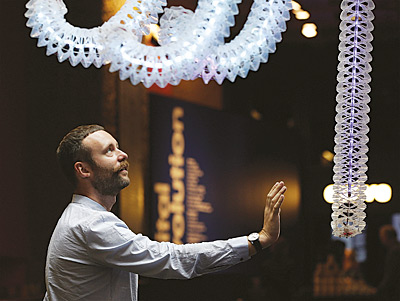|
The Treachery of Sanctuary by Chris Milk, 2011 |
||
|
Fun, FX and nostalgia are to the fore as the Barbican attempts to cram several trillion pixels of digital history into a single real-life gallery, writes Isabel Stevens For the Barbican’s exploration of digital creativity, the claustrophobic Curve gallery has been transformed into an arcade. It’s dark and busy. A soundtrack of Tetris boings and Human League synth throbs blares out. Visitors are drawn like moths to the small booths and their screens. Above loom nine large screens advertising the wares on show. On the floor, projected pixels dance about. In this hyperactive pleasure-ground you can time-travel back to when pixels entered our lives (with the first games console, Ralph Baer’s Magnovox Odyssey in 1972). Playing is encouraged and almost everything has instructions, with most games and art faithfully displayed on their original hardware. There are many 30-plus adults taking photos (The Quantel Paintbox! The Commodore Pet 2001 home computer! The Sinclair ZX80!), and you overhear lots of exchanges like this – Father: “I used to have one of these.” Son: “It’s huge.”
Assemblance by Umbrellium, 2014 There are hit games like Pong, Pac-Man and Mario Bros to fall back in love with, but what’s here beyond nostalgia? There are some rather nice juxtapositions: early idiosyncratic computer games like the zero-player Game of Life which illustrates civilisation’s ebbs and flows in evolving groups of black and white squares; and little-known digital animators such as Lillian F Schwartz, whose 1970 psychedelic blitz short Pixillation is seen next to big-screen FX spectacles such as The Abyss (1989)and Jurassic Park (1993). Another highlight is the mix of video games with early examples of computer art. Lynn Hershman Leeson’s Lorna (1983), the first interactive laser artdisc, provides what is missing from many of the experiences that surrounding exhibits offer: emotion. Dedicated “to all the anonymous in the world”, Hershman Leeson’s “game” centres on the agoraphobic Lorna. Participants explore her past and future by clicking on objects in her apartment, to generate their own plot rather than being taken on a predetermined route. Choosing normal life over a fantasy world, this rarely exhibited melancholy experiment is a stark contrast to the uplifting distractions of most video games: one possible outcome is Lorna’s suicide. A desire to disrupt and critique digital media is also explored in the deviant net-art projects of the 1990s. Compare landmarks such as Tim Berners-Lee’s 1991 launch of the World Wide Web with the absurd endeavours of abstract HTML works such as Alexei Shulgin’s Form Art (1997).
Petting Zoo by Minimaforms, 2013 Nowhere in the show are the advances in digital technology more clearly illustrated than in the cinema exhibits. You can observe CGI pioneers strive for photorealism throughout the 1980s and 90s and then explore the gargantuan and painstaking work of effects studios such as Double Negative and Framestore as they construct outer space and cities out of pixels and only a slither of reality. Sadly, those interested in today’s artists doing interesting things with CGI and digital worlds will have to travel across London to visit Ed Atkins’s exhibition at the Serpentine Gallery. The contemporary art on display is largely of the immersive, kid-friendly variety – butterflies and birds that react to your movements, empty silhouette spectacles that are easily captured on camera. After a collection of innovative music videos (for artists such as Björk, Arcade Fire and Brian Eno), a whole section of the show is given
Wishing Wall by Varvara Guljajeva and Mar Canet, 2014 The digital artist and musician turned video game-modifier Cory Arcangel works in a very different context (the art world), but as a pioneer of technology-based art, he is strangely absent from the show, and one wonders what he might have done with this space. Digital Revolution crams a lot in and, with its desire for mass-interaction, spills out into the rest of the Barbican. Yet such a huge brief inevitably falls short. Design and architecture are superficially explored. And what about photography, an art form that has been colonised by the pixel? Most galling is the hagiographic tone of some of the wall texts. “He didn’t let us down,” cheers one blurb about Steve Jobs, next to an iPhone exhibit. The experiential digital timeline at the show’s start illustrates how rarely early computer art is exhibited in galleries and how fragile and in need of preservation much of it is. The rest just leaves you wishing for a narrower focus. Digital Revolution runs at the Barbican until 14 September. Watch an interview with the exhibition’s curator Conrad Bodman |
Words Isabel Stevens
Images: Matthew G Lloyd – Getty Images
Digital Revolution |
|
|
||






















